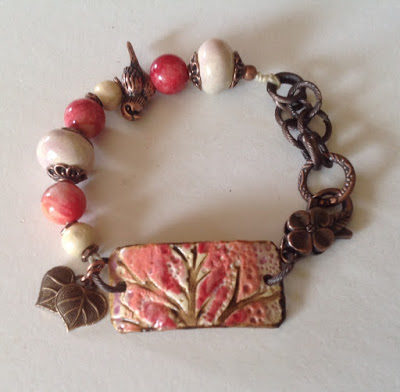 I thought that this faux vintage necklace needed three strands to make the holiday party statement I was hoping to create, but I didn’t have any three-to-one connectors, and the stores were closed. What to do, to stay on schedule for those last minute gift creations? Since there was a lot of copper in the necklace components and I had 18 gauge copper wire handy, I decided to make the connectors, and you can do it for your art bead necklace or bracelet designs, too!
I thought that this faux vintage necklace needed three strands to make the holiday party statement I was hoping to create, but I didn’t have any three-to-one connectors, and the stores were closed. What to do, to stay on schedule for those last minute gift creations? Since there was a lot of copper in the necklace components and I had 18 gauge copper wire handy, I decided to make the connectors, and you can do it for your art bead necklace or bracelet designs, too!

The supplies you’ll need are very simple, just your round nose pliers (I used my rosary pliers), some 18 gauge wire, either silver, copper or brass based on your design, and flush cutter wire snips for a nice clean edge. These are pretty standard and most likely you already own all of them.
For my three-to-one connectors I used 3 inches of 18 gauge copper wire. How much you need will depend on your design and the gauge of wire, but be generous, better to have too much and clip off the excess than to run out of wire in the middle of the project. Place your round nose pliers in the center of the wire and create your first loop – this is the top loop that will be a single. So if you want the top loop to be the largest, now is the time to decide that. It looks like a loop with two legs of wire going in opposite directions.

Next, take one leg of the wire and make a twist directly underneath to create the center loop of the bottom three for the three-to-one connection. On your pliers, it now looks like a figure 8 over the nose of the pliers with two long legs on either side of the waist of the figure 8.

Take the next long leg on either side and curl it in a loop toward the loop on the bottom of the connector. You can adjust the size of the loop until it matches or complements the center bottom loop. You may want your bottom loops slightly smaller than the upper loop, now is the time to make that choice.
 Now return to the other long leg on the opposite side and curl it toward the center bottom loop, matching the size of the loop to the other two on the bottom. When you have both loops on either side of the center bottom loop adjusted, you can clip the extra length off the wire of each leg and nestle the loops close into the central bottom loop. There’s your three-to-one connector!
Now return to the other long leg on the opposite side and curl it toward the center bottom loop, matching the size of the loop to the other two on the bottom. When you have both loops on either side of the center bottom loop adjusted, you can clip the extra length off the wire of each leg and nestle the loops close into the central bottom loop. There’s your three-to-one connector!

These three-to-one connectors I left in rounded wire, but sometimes I hammer them, to make them flat on the loops. If you have the hammer and bench anvil to do that, just be sure that you don’t hammer on the part of the component where the wires cross each other. It will make the wire brittle and it may snap when you are using it.

Once you’ve made a three-to-one connector, it’s easy to use the same methods to make a two-loop or a three-loop connector the same way. You can be as fancy or simple as you want with your wire work. To make the necklace I strung my hand-dyed costume pearls with glass beads and a faux vintage charm, made a strand of rosary wrapped pearls and used a length of brass chain. My three-strand necklace was complete, and I didn’t have to go in search of findings.

Attach some large link copper chain to the top loops of the 3-way connector with a copper clasp on one side attached to the top loop of the 3-to-one component, and your special dress-up necklace or bracelet is all ready to wear or gift!


Karen
December 11, 2008 at 7:15 pmExcellent idea, Lynn, thanks so much for the great inspiration!
Meekiyu
December 11, 2008 at 8:34 pmmy goodness those are some really awesome directions and pictures. Great tutorial!! =D
HINT Jewelry Design
December 11, 2008 at 11:40 pmI love the three strands. Really speaks to me of celebration. How clever making your own connector. I’ll have to try it out! Thanks for the tutorial 🙂
Cindy Lietz, Polymer Clay Tutor
December 11, 2008 at 11:59 pmI love to make copper findings! Copper is so soft and easy to work with and the color is so warm and beautiful. Great designs! Thank you for sharing them with us!
A Beaded Affair
December 14, 2008 at 4:07 pmCopper is wonderful to work with. I’m going to give your connector a try this afternoon. Finding blogs with tuts is fun. I’ll check back soon.
Lois
http://www.abeadedaffair.com